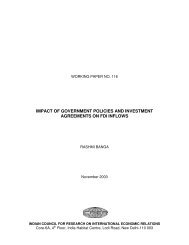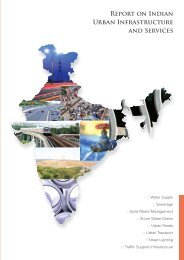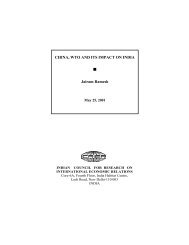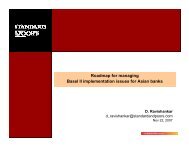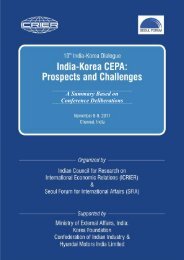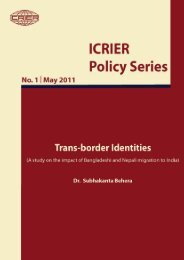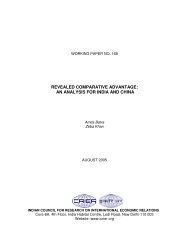Asia's Arc of Advantage - icrier
Asia's Arc of Advantage - icrier
Asia's Arc of Advantage - icrier
You also want an ePaper? Increase the reach of your titles
YUMPU automatically turns print PDFs into web optimized ePapers that Google loves.
co-operation. Although the pace <strong>of</strong> India’s integration has been slow, it has slowly but certainly<br />
begun to change the geopolitical conceptions <strong>of</strong> Asia and erase the differences between East<br />
Asia and South Asia. Intensifying this process was the rapid economic growth <strong>of</strong> China. The<br />
development <strong>of</strong> China’s eastern seaboard in the early years <strong>of</strong> reform saw the integration <strong>of</strong> the<br />
Chinese economy with that <strong>of</strong> East Asia. When China launched its West Region Development<br />
Strategy in 2000, it focused on connecting its underdeveloped regions in the far west and south<br />
west with Southeast Asia, South Asia and Central Asia. The more recent opening <strong>of</strong> Myanmar,<br />
the last major economy in Southeast Asia to globalise, will make sure that the geographic<br />
distinctions between different parts <strong>of</strong> Asia will increasingly break down.<br />
The growing economic integration <strong>of</strong> Asia with itself is not limited to land territories. It has<br />
also brought forth a strategic perspective that sees the Pacific and Indian Oceans as a single<br />
continuum. East Asia’s early industrialisers, Japan and Korea, have long been dependent on the<br />
energy resources <strong>of</strong> the Gulf. China’s economic modernisation has made that interdependence<br />
much stronger. China has not only become one <strong>of</strong> the biggest importers <strong>of</strong> oil from the Gulf,<br />
it has also increasingly focused on Africa for energy and mineral resources. Unlike many East<br />
Asian countries that have been content to rely on the United States for the maintenance <strong>of</strong><br />
order in Asia’s high seas, China is clearly focused on building independent blue water naval<br />
capabilities to secure its expanding interests in the Indian Ocean. It is also actively constructing<br />
strategic maritime infrastructure in the Indian Ocean that will facilitate the pursuit <strong>of</strong> its growing<br />
maritime interests in the Indian Ocean. Meanwhile, India’s trade and economic relations with<br />
East Asia are acquiring greater weight, with more than fifty per cent <strong>of</strong> its trade flows now<br />
heading east. India’s stake in the political stability and security <strong>of</strong> the Western Pacific has also<br />
steadily risen. New Delhi’s ‘Look East’ policy has acquired a distinct naval dimension over the<br />
last decade. Since the beginning <strong>of</strong> the 2000s, the Indian Navy has made continuous forays into<br />
the Western Pacific. The traditional clear distinctions, then, between the Indian Ocean and the<br />
Pacific are beginning to erode. The economic transformation <strong>of</strong> China and India has begun to<br />
bend the spaces around them and produce new geographic constructions. The economic growth<br />
in East Asia in the 1980s generated the concept <strong>of</strong> the ‘Pacific Rim’. The expansion <strong>of</strong> this growth<br />
to Southeast Asia led to the construction <strong>of</strong> the term Asia-Pacific. China’s increasing reliance<br />
on the Indian Ocean and the acceleration <strong>of</strong> India’s economic growth and strategic interests<br />
in the Pacific has now led the increasing use <strong>of</strong> the term, ‘Indo-Pacific’. The intersection <strong>of</strong> the<br />
maritime interests <strong>of</strong> a rising China and an emerging India with those <strong>of</strong> the United States that<br />
has long provided security in the two oceans has begun to give the ‘Indo-Pacific’ a distinctive<br />
geopolitical character. 8<br />
The idea <strong>of</strong> Indo-Pacific, which has gained some traction in recent years, is not entirely new. The<br />
German geopolitical thinker Karl Haush<strong>of</strong>er had expanded upon the idea <strong>of</strong> “Indopazifischen<br />
Raum” or the ‘Indo-Pacific space’ in the 1920s. Before him, Mahan saw Asia and its waters as a<br />
single space. The Second World War, as we noted earlier, saw the two theatres as a single military<br />
zone. And the British imperial defence system stretched from the eastern Mediterranean to<br />
the South China Sea and was centred on India. What is new and more current has been the<br />
tendency to see Asia as consisting <strong>of</strong> separate zones and dividing its littoral into the Indian and<br />
8 For a discussion <strong>of</strong> the emergence <strong>of</strong> the concept see, David Scott, “The Indo-Pacific: New Regional<br />
Formulations and New Maritime Frameworks for U.S.-India Strategic Convergence”, Asia-Pacific Review,<br />
Vol. 19, No. 2, November 2012, pp. 85-109.<br />
40 | Asia’s <strong>Arc</strong> <strong>of</strong> <strong>Advantage</strong>







